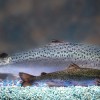Tedi Setton
This user hasn't shared any biographical information
Homepage: http://dnalc.org/about/staff/setton.html
Posts by Tedi Setton

Malaria Mystery: SOLVED
Dec 15th
Normal and Sickled Red Blood Cells
While scientists have long known that carriers for Sickle Cell Trait are more resistant to Malaria infection, the mechanism by which protection is conferred has not been well understood—until now. Scientists at Heidelberg University used an electron microscope to observe what happens when the parasite that causes Malaria in humans, Plasmodium falciparum, infects red blood cells containing both healthy and mutant hemoglobin.
Scientists noticed that in red blood cells with healthy hemoglobin, the parasite hijacks the actin cytoskeleton to transport its own “adhesin” protein to the cell membrane. The adhesin, also called Plasmodium falciparum Erythrocyte Membrane Protein 1 More >
AIDS Cure UPDATE
Oct 15th
Back in February, I blogged about a patient who received a bone marrow transplant, from an HIV-immune donor, that cured both his leukemia and AIDS. I mentioned that while bone marrow transplants were impractical as a primary treatment for AIDS, I suggested that perhaps gene therapy tactics could be employed to achieve the same effect. For the first time, scientists at Sangamo BioSciences have shown that this may actually be possible.
HIV infects white blood cells by latching onto two protein receptors, CD4 and CCR5. Scientists noticed that people with a defect in the CCR5 gene (a 32-bp deletion) are incapable of More >
Biological Warfare
Sep 15th
Scientists at the Universities of Nottingham and Maastricht have engineered a strain of bacteria that may be able to fight cancer!
Clostridium sporogenes are anaerobic soil dwellers which cannot survive in the presence of oxygen. Researchers have genetically modified these bacteria so that they produce an enzyme that activates a cancer drug. It turns out that the centers of solid cancer tumors contain very little oxygen. Researchers hope to inject cancer patients’ tumors with the engineered Clostridium spores, which would not survive in the rest of the oxygen-rich body. After a tumor is infected with the Clostridium, a patient would also be More >

Fine Food or Freak Fish?
Sep 27th
Science experiments are not usually meant to be eaten; even water and gum are strictly banned from laboratories. But as scientists continue to perfect techniques for genetic manipulation, the products of their experiments are increasingly making appearances in super markets and on dinner tables.
While the genetic modification of plants for human consumption is common in the United States (think corn and soybeans), genetically modified (GM) animals have yet to be approved. But now, a Massachusetts-based company, AquaBounty, is petitioning the FDA to sell genetically modified Atlantic Salmon to consumers.
Thanks to some genetic mix and match, the salmon, dubbed AquAdvantage, reach More >

Pharm Crops
Apr 19th
What if vaccines could be eaten instead of injected? Scientists began developing subunit vaccines in the late 1980s; these are vaccines which contain isolated pathogen proteins. It seems that proteins from viruses, bacteria, and parasites can trigger an immune response (are antigenic) even when the pathogens are not present. Furthermore, these proteins can be antigenic when eaten, which has led scientists to explore whether we can genetically modify food sources to create edible vaccines.
Dr. Charles Arntzen (Co-Director of the Center for Infectious Diseases and Vaccinology, The Biodesign Institute and Florence Ely Nelson Presidential Chair, Arizona State University) has spearheaded the More >
AIDS Cure?
Feb 5th
How do you cure a man of both leukemia and AIDS with just one procedure? No, it’s not a trick question: an American leukemia patient living in Berlin received a bone marrow transplant that also resolved his AIDS.
In a bone marrow transplant, a patient’s own marrow is destroyed and replaced with tissue from a donor. The donor marrow contains healthy hematopoietic stem cells (HSCs, adult stem cells in the blood) which repopulate the patient’s body with healthy red and white blood cells for oxygen transport and immune defense. Just as with other varieties of organ donation, tissue-type matches are critical. In the case of More >

Lighting-Up Landmines
Dec 7th
Engineering students at Edinburgh University have created bacteria that can be used to detect landmines! The cheaply engineered bacteria can be mixed into a colorless fluid which would be sprayed over suspect soil. Chemicals that leak out of old landmines stimulate the bacteria to make a green protein, producing large patches of bright green where bacteria encounter explosive material.
According to the United Nations, between 15,000 and 20,000 people are injured or killed by landmines that litter more than 80 countries including Sudan, Somalia, Iraq, and Afghanistan. The bacteria would likely fail to identify those mines that do not leak, and would detect More >
Who’s My Other Mommy?
Oct 26th
Fraternal Rhesus Macaque twins, Mito and Tracker, have two different DNA mommies: their mother’s chromosomal DNA was injected into enucleated egg cells belonging to another Rhesus monkey female prior to fertilization. The eggs were fertilized, in vitro, with donor sperm and implanted in yet another female who carried the healthy twins to term.
The nucleus, where chromosomal DNA is stored and protected, is not the only source of DNA in a mammalian cell. Mitochondria have their own 16,569 bp genomes encoding 37 genes involved in the production of biological energy, ATP. Mutations in these genes have been linked with human diseases More >

Pharmacowhat? Pharmacogenetics!
Oct 15th
Your genes affect not only how you look and your predisposition to disease, but it would appear that they also affect your responsiveness to different drug treatments following disease onset.
In the emerging field of pharmacogenetics, scientists study genome variations and correlate them with drug treatment response. For example, variations (also called polymorphisms) in genes encoding enzymes involved in drug metabolism have been found to affect the activation, deactivation, and toxicity of drugs used to treat cancer, heart disease, and psychiatric disorders. Recently, scientists found that DNA sequence can also be used to predict responsiveness to current Hepatitis C treatment (a More >
